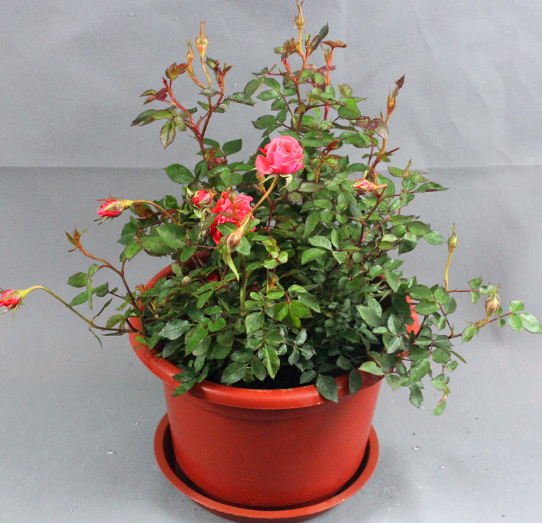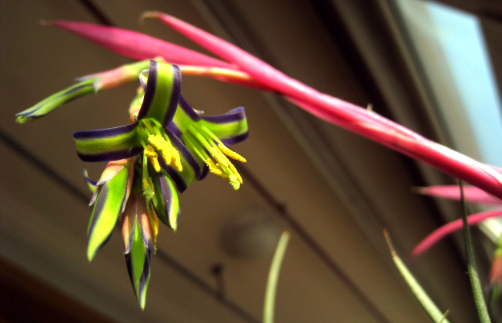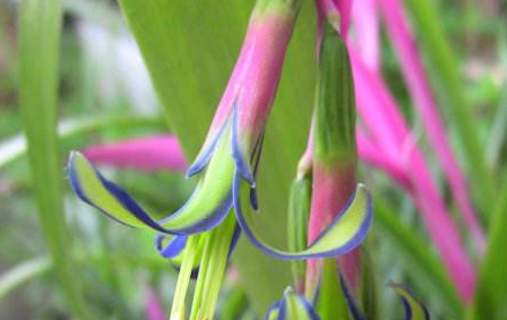Matters needing attention in rose culture
1. Anti-freezing.
Rose has a strong cold tolerance, which can withstand the low temperature of-10 ℃. Generally speaking, the south can be placed directly under the eaves facing south for the winter, while the northern potted rose moves inward to indoor ventilation when the temperature drops to 10 ℃. It should be noted that after the flowers wither in October, do not prune, apply a mature phosphate fertilizer to promote the branches strong and full, enhance the cold tolerance. In addition, when the temperature is very low in winter, it can be properly watered when it is slightly warmer to prevent the plant from dying from dry freezing.

2. Trim.
When the new branch of rose grows to 15-20 cm, it needs to cut off about 3 cm at the top to promote the formation of branches, and when the lateral branch grows to a certain extent, it can also be coring, constantly repeating, which can make the rose plant type plump and bloom more flowers.
3. Put on the basin.
Potted rose culture after a certain period of time to change the pot transplanting, pot change is generally carried out before sprouting in early spring, change part of the new soil, water thoroughly, put in a cool place, a week later transferred to a sunny place for maintenance.
4. Pest control.
Pay attention to maintaining good ventilation and adequate light in the culture environment, otherwise rose flowers are easily disturbed by diseases and insect pests, such as aphids, powdery mildew, black spot, etc., and the occurrence of diseases and insect pests is timely spraying to avoid affecting flowering.
Flower friends who like rose take a look at the above introduction of breeding methods, and quickly start raising a pot on your own.
How to cultivate Rose with large Flower
Although the breeding methods and matters needing attention of Chinese rose are relatively comprehensive, they are easy to understand. Even beginners can easily learn to breed rose after learning.
Culture methods and matters needing attention of large flower rose
Seed selection: varieties that require cold tolerance, strong stress resistance, resistance to diseases and insect pests, vigorous growth, hard pedicels, more flowering, early flowering, large and colorful flowers, good flower shape, long single florescence, and are popular in the market those varieties with close leaves, short and strong plant shape, short and hard pedicels are better, more suitable for pot culture. Moreover, some new species should be introduced year after year to fill the population and eliminate the poor old varieties. There is no need to have too many commercial varieties, there are 100 varieties in charge, and other rare varieties that are favored by old flower friends can be properly collected.
Planting: the plant-row spacing of Chinese rose varies according to the purpose of cultivation. The row spacing of 150 cm × 80 cm is commonly used in variety nursery for breeding or scientific research. The seedlings should be pruned before planting, including damaged branches, diseased branches and weak branches, and damaged or overgrown roots should also be cut off. After pruning, smear the wound with healing film to make the wound heal quickly.
Environment: big flower rose is a light-loving plant. In the process of cultivation, you should choose sunny ground and avoid planting in the shady side of tall buildings, trees and hillsides. The ideal soil for cultivating large flower rose should have good aggregate structure and rich content of organic matter.
Watering: after the Beginning of Spring, in order to prevent the tender leaves from wilting, you can use your fingers to dig the mouth of the basin. When you see the surface, the sand is dry, and it is necessary to water it. Spray with a spray can and water thoroughly twice. It is best to take notes after each watering, and also write down the inferred date of the next watering. After a few times, you can find out the general rule. In short, do not dry, do not soak the root, do not make it grow in vain.
Fertilization: the amount of fertilizer required is small, and the basic fertilizer has been applied during soil preparation, so there is no need for soil fertilization before seedling transplanting, but foliar fertilization should be carried out. That is, after cutting for one month, 0.3% urea liquid fertilizer and 0.2% potassium dihydrogen phosphate liquid fertilizer are used in turn every half a month for foliar fertilization to promote rooting.
Temperature control: the plastic shed can adjust the temperature and humidity of soil and air, and the sunshade net can prevent direct sunlight and reduce the temperature. The best temperature for rooting of Chinese rose is 20 ℃ to 25 ℃. When the temperature is too high, it can not only cover the sunshade net, but also be watered and ventilated.
Overwintering: Xiaomiao overwintering in the long winter of more than 5 months, to ensure that Xiaomiao "sleep" safely and comfortably, must be particularly careful. After Cold Dew, before the cold spell comes, move Xiaomiao to the greenhouse to ensure that he sees at least 4 hours of sunshine every day. After that, the management is watering and temperature control. The daytime temperature is 3-4 ℃, it is best not to exceed 5 ℃, otherwise it should be ventilated and cooled in time, and the lowest at night is-4 ℃.
Other varieties of Chinese rose
Small rose: if there is a big rose in the rose, of course there will be a small rose. The small rose plant is short and much branched, the height is generally no more than 25cm, the leaf is small and narrow, the flower is also small, about 3cm in diameter, rose red, double or single, this small rose flower is suitable for potted bonsai.
Discolored rose: a discolored rose, the name seems to be very attractive. The so-called discolored rose flowers do not automatically change color, but because the pH absorbed by the Corolla is inconsistent in the process of flowering, resulting in discoloration due to different time.
Vine rose: the resistance of vine rose is very strong, and the vine develops very fast and grows strong. A vine rose can send out 7-8 main branches a year, and each main branch can branch out. It has disease resistance. Rosa chinensis flowers bloom continuously throughout the four seasons, with bright colors, fragrant smell and long flowering period. It can be used as flower ball, style, flower wall, flower sea, arch shape, corridor shape and so on.
Ground cover rose: the growth form of ground cover rose is different from that of general Chinese rose, the ground cover rose is creeping and expanding, and the tillering rate is very strong. Each plant can produce more than 50 branches a year, and each branch can blossom 500-100. It is also a kind of plant that is resistant to cold and high temperature.
No matter which kind of rose is of high ornamental value, and the big rose is undoubtedly one of the outstanding ones, if there are friends who want to adjust their life with some flowers, then the big rose will be a good choice.
How to raise potted rose culture matters needing attention
There are many varieties of Chinese rose, the flower shape is large and beautiful, and it is very ornamental, so many flower friends will put a pot indoors. So, how to raise potted rose? What do you need to pay attention to when breeding? Next, I will introduce the breeding methods and matters needing attention of potted rose.
How to raise potted rose
1, choose a good basin, choose purple sand basin, it is not difficult to understand that this is more related to the air permeability mentioned above.
2, use good soil, choose loose soil with good permeability, do not use clayey soil, the second is that the soil should be rich in organic matter.
3, timely planting, preferably in spring, if you want to plant in autumn, it is best to plant with soil, and it is best to put the seedlings in a place with suitable sunlight and good ventilation, after the seedlings have survived, you can prune it a little according to what you want to see in the future, so that its branches are reasonable and plastic in the future.
4. Water reasonably and keep the basin soil moist as far as possible before rose sprouting, so that the soil is not dry or irrigated. After germination, the number of watering will gradually increase, generally about twice a day, watering once before 10:00 in the morning, and then watering the basin soil appropriately according to its dry and wet condition in the afternoon. Pay special attention at noon, during which many friends may forget some common sense of life, that is, if the sun is particularly strong at noon, especially in summer, watering should not be poured on the leaves of the rose, as it will burn it. As the average person's summer watering will kill the rose, it is recommended that it be watered once in the morning and evening in summer, not at night.
5, regular fertilization, rose like fertilizer, generally in spring and autumn during the two peak growth seasons, fertilization every 10-15 days, with fertilizer, organic fertilizer and compound fertilizer can be. Fertilization should be stopped in hot summer and cold winter.
6. In the breeding place, because the rose is bright, you can put your rose in a sunny and well-ventilated place, but you should give it proper shade in summer.
7. Pruning, when the flowers are withered, part of the branches should be cut off, leaving the new branches 2-3 nodes and then cut off. If the cut branches have more than 2 nodes, they can be used for cutting propagation. Winter pruning is mainly plastic surgery, generally cutting off disease and insect branches, withered branches and intersecting thin and weak branches, and for roses with strong growth and symmetrical plant type, cut off 1 inch and 3 of the whole plant. For the plants with weak growth, about 2 prime 3 of the whole plant was cut off, leaving only 3-4 strong main branches.
8. If you turn the basin, it is best to turn the basin every 1-2 years, remove the old soil of 2 picks and 3, replace it with rich soil rich in organic matter, turn the basin during spring sprouting, cooperate with turning the basin, cut off the branches of diseases and insect pests, withered branches, cross thin and weak branches, cut short and long roots, remove a large part of the old roots from Migen, promote the germination of new roots, and make them grow more exuberantly in the next growing season.
Matters needing attention in potted rose culture
1. Temperature: sex likes warmth, is afraid of heat, and is more hardy. The most suitable temperature for the growth of Chinese rose is 22: 25 ℃. (PS: the optimum temperature is 15: 26 ℃ during the day. 10: 15 ℃ at night).
two。 Rizhao: rose flowers like a sunny, well-ventilated, well-drained and sheltered environment. Dear, remember not to raise rose flowers in dark and damp places! Into the middle of summer, it is necessary to give proper shade to flowers! Otherwise the flowers in full bloom are easy to dry up.
3. Moisture: our rose flowers like to be moist (the air relative humidity should be 75%-80%). At the same time, it is bearable for a certain degree of drought, so it is not a flower in a greenhouse!
4. Soil: the soil for growing Chinese rose should be fertile, loose and well drained. When I was a child, I often dug the soil in spring to plant it. It felt good. It is not easy to find in the city, here to remind the children's shoes who love flowers, the soil you choose must not be that kind of caking, because the drainage is poor, you can choose slightly acidic soil rich in humus. In fact, rose flowers can adapt to the soil relatively wide.
5. Fertilization: it is the peak growing season of rose after May. Topdressing should be applied every 10 days. The rotten and fermented fish juice and vegetable leaf juice can be mixed with 3 parts of fertilizer and 7 parts of water, and the fertilization will be stopped in November.
6. Watering: for the watering of Chinese rose, we first need to know a little bit, because everyone chooses different culture conditions, such as soil quality, light, temperature and humidity, so we can irrigate according to the drying condition of potted soil when watering. My principle for watering flowers is: if you don't do it, you must water it thoroughly after it is dry.
7. Loosening soil and weeding: combined with the removal of basin weeds, fine wire rake can be used to gently break the surface of the soil around the flowerpot to enhance the looseness and ventilation of the potted soil and promote the normal growth of the root system.
The above is for everyone to introduce the potted rose culture methods and points for attention, everyone is clear? Please pay attention to more household knowledge.
- Prev

The Propagation method of Flos Lonicerae
The main results are as follows: 1. in tissue culture, the ramet and cuttage propagation growth rate is slow, and the number of seedlings obtained is small and irregular. The large-scale propagation of commercial varieties is mostly based on tissue culture, and the stem tip tissue of tillering buds is used as material.
- Next

Culture method of pendulous water tower flower
1, temperature hi warm climate, suitable for growth temperature of 21-27° in ornamental pineapple belongs to the type of strong adaptability to temperature, tolerance of 2-5° low temperature. In South China, the plants can overwinter in the open field, but in the north, they need to be moved indoors to keep warm during overwinter, and plastic bags should be used to cover the plants when cold weather strikes.
Related
- Fuxing push coffee new agricultural production and marketing class: lack of small-scale processing plants
- Jujube rice field leisure farm deep ploughing Yilan for five years to create a space for organic food and play
- Nongyu Farm-A trial of organic papaya for brave women with advanced technology
- Four points for attention in the prevention and control of diseases and insect pests of edible fungi
- How to add nutrient solution to Edible Fungi
- Is there any good way to control edible fungus mites?
- Open Inoculation Technology of Edible Fungi
- Is there any clever way to use fertilizer for edible fungus in winter?
- What agents are used to kill the pathogens of edible fungi in the mushroom shed?
- Rapid drying of Edible Fungi

